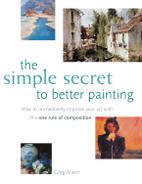introduction
How often do you look at your just-completed painting or drawing and have the nagging feeling it just isn’t right? That the picture is not as satisfying as it should or could be? And that you can’t quite figure out what would make it better?
You look at your painting and study it. The proportions are right, the perspective is fine and the colors match what you see. Still, something makes the painting look a bit wrong. It doesn’t look balanced, or something about the arrangement of the shapes is distracting. It just doesn’t “work.” You’re at a loss as to what is exactly wrong or what to do about it.
This book will not only give you a tool to identify what is wrong with a painting that isn’t quite right and what to do to make it better, but it will give you a simple tool to make better paintings from the start. The secret is in designing the painting so it is a great composition.
Like Goldilocks, we want to create a composition with shapes, colors, textures and other elements that are not too dull, not too distressing, but “just right.”
![]()
The secret for designing great compositions
Much has been said about how to design great pictures. Whole books have been written about the art or even science of pictorial composition. Some of it is surprisingly complicated, using the geometry of the ancient Greeks as its base.
But much of what has been said about composition is utterly useless when you’re standing in front of a blank canvas. All the formulas and theories don’t help you then. In fact, they can just make you more confused and bewildered, adding frustration to an already daunting challenge.
Applied consistently, one rule of composition will eliminate all the most subtle design flaws. The ONE RULE is:
Never make any two intervals the same
Intervals that are the same are boring. Intervals that vary are interesting. In this book, you will learn how this rule can be applied not only to intervals of distance, but also to shape, tonal value, color and just about every other element in your painting.
You will be surprised how often the ONE RULE OF COMPOSITION can be used and how easy it is to remember. You can use it when you begin painting to avoid mistakes from the start. You can use it when you are in the midst of painting to make the right decisions about color and value. You can use it when you’re done painting to analyze the picture to determine how it could be improved. You can also use it to critique any painting to learn how you could have made the picture better.
This book is designed to be read quickly and remembered forever. Once you see how this one rule of composition is so far-reaching and effective, you will find yourself applying it automatically. You’ll wonder how you ever made a well-composed painting on purpose without it.
So, with an open mind, let’s begin.

Near Knowlton’s Corner ![]() Greg Albert
Greg Albert ![]() 16" x 20" (41cm x 51cm)
16" x 20" (41cm x 51cm) ![]() Oil on canvas
Oil on canvas

Barn Owl ![]() Tom Gallovich
Tom Gallovich ![]() 30" x 22" (76cm x 56cm)
30" x 22" (76cm x 56cm) ![]() Watercolor on paper
Watercolor on paper
